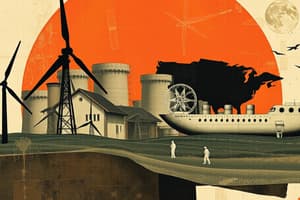Podcast
Questions and Answers
What is the main characteristic of renewable energy sources?
What is the main characteristic of renewable energy sources?
- They come from natural sources that do not deplete (correct)
- They emit CO2 and harmful gases
- They include fossil fuels
- They are finite resources
How is solar energy typically converted for use?
How is solar energy typically converted for use?
- Into natural gas
- By burning fossil fuels
- Into thermal or electric energy (correct)
- By fission of uranium
Which energy source is primarily responsible for generating electricity from the movement of water?
Which energy source is primarily responsible for generating electricity from the movement of water?
- Geothermal energy
- Solar energy
- Wind energy
- Hydroelectric energy (correct)
What negative environmental impact is associated with non-renewable energy sources?
What negative environmental impact is associated with non-renewable energy sources?
Flashcards are hidden until you start studying
Study Notes
- Energy is anything capable of causing a change in matter. It is present everywhere and can be transformed or transferred between objects.
- Energy cannot be created or destroyed, only transformed or transferred.
- There are two types of energy sources: renewable and non-renewable.
- Renewable energy sources come from natural sources that do not deplete, such as solar, wind, and water.
- Solar energy comes from the sun and can be converted into thermal or electric energy.
- Wind energy is generated by the motion of wind and can be converted into electric energy.
- Hydroelectric energy is generated by the movement of water and is stored in dams or embalses.
- Geothermal energy is obtained from the heat within the earth and can be used for heating or electricity generation.
- Renewable energy sources are environmentally friendly, as they do not emit CO2 or harmful gases.
- Non-renewable energy sources include fossil fuels and nuclear energy.
- Fossil fuels, such as petroleum, are finite resources that can be extracted and burned for energy.
- Coal is a non-renewable resource that is extracted from the ground and burned for heating or electricity generation.
- Natural gas is extracted from the ground and used for heating and electricity generation.
- Nuclear energy is generated from the fission of uranium and can be converted into electric energy.
- Non-renewable energy sources have negative environmental impacts, including air pollution and greenhouse gas emissions.
- To meet global energy demands and protect the environment, it is important to reduce the use of non-renewable energy sources and increase the use of renewable energy sources.
Studying That Suits You
Use AI to generate personalized quizzes and flashcards to suit your learning preferences.




